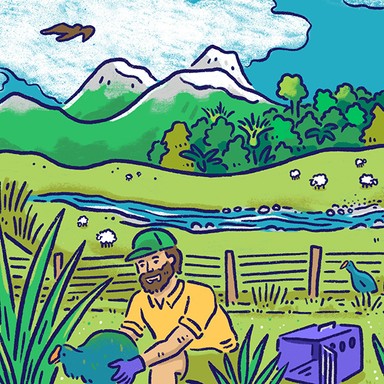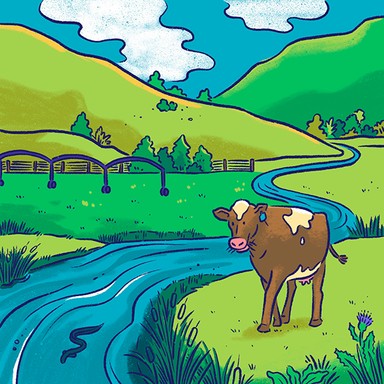
Bay of Plenty Regional Council

Environment and biodiversity
Protecting the environment and managing natural resources is a key responsibility of regional councils. Regional councils are often also involved in pest control and resource management.

Environment and biodiversity
Protecting the environment and managing natural resources is a key responsibility of regional councils. Regional councils are often also involved in pest control and resource management.
Establish less harmful pest management programs that benefit the community and provide jobs. Poisoning an ecosystem is not a solution.
Reduce genuinely environmentally harmful runoff and emissions instead of focusing on stock emissions.
Work with the people of Bay of Plenty to protect our ocean's biodiversity while also supporting recreational, commercial and customary fishing.
Reduce the amount of microplastics entering Tauranga Harbour, the ocean, fish and shellfish, and ultimately our diet and bodies.
Reduce the flow of pollutants and sediment into Tauranga Harbour, and start reversing the degradation caused by decades of mismanagement.
Rejuvenate our biodiversity with wetland restoration. I chair the Tauranga Rotary Centennial Trust for the restoration of Kopurereua Valley.
Ensure excellence in environmental monitoring – if we don't measure we can't effectively manage, and good data allows science-based decision making.
Commit to effective plant and animal pest control. Our council is great at the hui, but often lacks the doey.
Action to protect and restore our environment and empowering community with more support for biodiversity and regeneration programmes.
Apply strategies to improve biodiversity, reduce pest incursion and expansion and support inter-regional and central government commitment.
Drive tighter measures and monitoring for clean air and protecting our whenua and moana from pollution, waste reduction initiatives.
Ensure the pest management plan delivers on plant and animal pests, including dama wallaby control and catfish population control.
Ensuring the delivery of the Air Quality Monitoring Programme, focusing on Mt Maunaganui industrial area and the Rotorua urban airshed.
Ensuring our community understands the state of the environment and is involved in its care. Effective limits in place, enforced, monitored.
Update and review emission consents in the industrial and commercial zones surrounding the Port of Tauranga with greater enforcement.
Continue to support and work with the volunteer community organisations doing important work in pest control and biodiversity restoration.
Monitor and reduce the air pollution now confirmed by a recent NZ study to be contributing to more than 1000 deaths per year.
Maintaining a healthy environment can only be done with a healthy economy. Reduce excessive consumerism, de-plasticise life, reusable ethos.
Exert responsible pressure on commercial, industrial and suppliers to reduce plastic wrap, packaging, recyclable and be optimally reusable.
Devise and refine strategies that effectively reduce waste, pollution and meet community expectations. Actively eradicate pest species.
Monitor water quality throughout the coastline.
Implement pest eradication where required.
Reintroduce native flora and fauna where it is required.
Continue environment agreements with landowners to reward good stewardship of the environment.
Investigate reasons and act to reduce the incidence of oil spills in the harbour (one a week in the last quarter of last year).
Resource planting programmes such as the 60,000 plants at Kaiate Falls.
Together we can create change, involved with native tree planting of Mauāo with Maungatapu School and Kopurererua Valley with Rotary.
Exploring natural alternatives to pesticides. Pro environmental monitoring/reporting. Support waste minimisation and waste-to-energy.
Balance between human activity and the natural environment. Encourage community engagement and participation, education, and feedback.
Develop and fund more partnerships to increase the delivery of enhanced biodiversity and pest management.
Increase education and community programs to ensure people take more ownership and stewardship of waste management and pollution.
Fund fit-for-purpose environmental response capability and capacity.
Establish less harmful pest management programs that benefit the community and provide jobs. Poisoning an ecosystem is not a solution.
Reduce genuinely environmentally harmful runoff and emissions instead of focusing on stock emissions.
Work with the people of Bay of Plenty to protect our ocean's biodiversity while also supporting recreational, commercial and customary fishing.
Reduce the amount of microplastics entering Tauranga Harbour, the ocean, fish and shellfish, and ultimately our diet and bodies.
Reduce the flow of pollutants and sediment into Tauranga Harbour, and start reversing the degradation caused by decades of mismanagement.
Rejuvenate our biodiversity with wetland restoration. I chair the Tauranga Rotary Centennial Trust for the restoration of Kopurereua Valley.
Ensure excellence in environmental monitoring – if we don't measure we can't effectively manage, and good data allows science-based decision making.
Commit to effective plant and animal pest control. Our council is great at the hui, but often lacks the doey.
Action to protect and restore our environment and empowering community with more support for biodiversity and regeneration programmes.
Apply strategies to improve biodiversity, reduce pest incursion and expansion and support inter-regional and central government commitment.
Drive tighter measures and monitoring for clean air and protecting our whenua and moana from pollution, waste reduction initiatives.
Ensure the pest management plan delivers on plant and animal pests, including dama wallaby control and catfish population control.
Ensuring the delivery of the Air Quality Monitoring Programme, focusing on Mt Maunaganui industrial area and the Rotorua urban airshed.
Ensuring our community understands the state of the environment and is involved in its care. Effective limits in place, enforced, monitored.
Update and review emission consents in the industrial and commercial zones surrounding the Port of Tauranga with greater enforcement.
Continue to support and work with the volunteer community organisations doing important work in pest control and biodiversity restoration.
Monitor and reduce the air pollution now confirmed by a recent NZ study to be contributing to more than 1000 deaths per year.
Maintaining a healthy environment can only be done with a healthy economy. Reduce excessive consumerism, de-plasticise life, reusable ethos.
Exert responsible pressure on commercial, industrial and suppliers to reduce plastic wrap, packaging, recyclable and be optimally reusable.
Devise and refine strategies that effectively reduce waste, pollution and meet community expectations. Actively eradicate pest species.
Monitor water quality throughout the coastline.
Implement pest eradication where required.
Reintroduce native flora and fauna where it is required.
Continue environment agreements with landowners to reward good stewardship of the environment.
Investigate reasons and act to reduce the incidence of oil spills in the harbour (one a week in the last quarter of last year).
Resource planting programmes such as the 60,000 plants at Kaiate Falls.
Together we can create change, involved with native tree planting of Mauāo with Maungatapu School and Kopurererua Valley with Rotary.
Exploring natural alternatives to pesticides. Pro environmental monitoring/reporting. Support waste minimisation and waste-to-energy.
Balance between human activity and the natural environment. Encourage community engagement and participation, education, and feedback.
Develop and fund more partnerships to increase the delivery of enhanced biodiversity and pest management.
Increase education and community programs to ensure people take more ownership and stewardship of waste management and pollution.
Fund fit-for-purpose environmental response capability and capacity.
Mayor
Compare the mayoral candidates in your area
Local council
Compare the candidates for your city or district council
Regional council
Compare the candidates for your regional council
Local board
Compare the candidates for your local or community board






